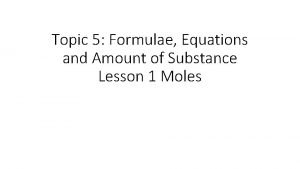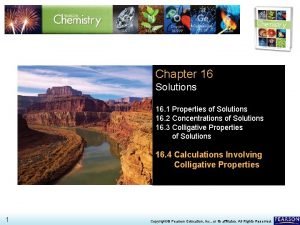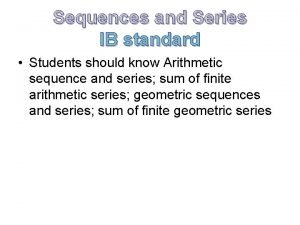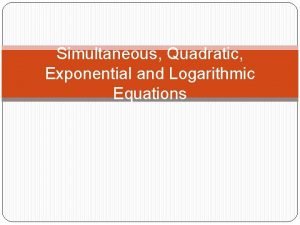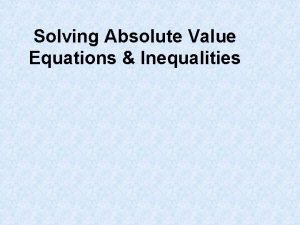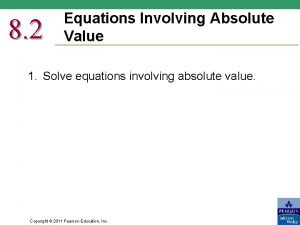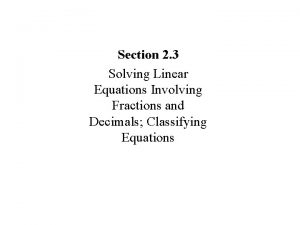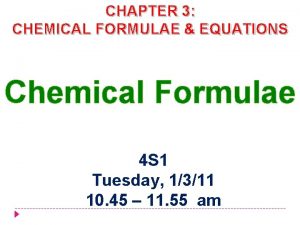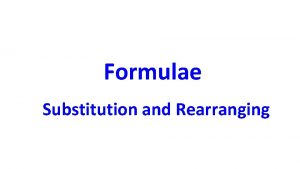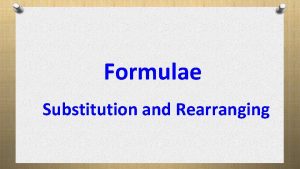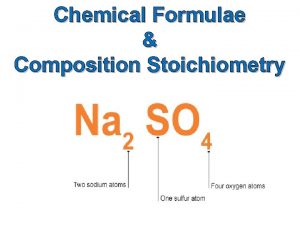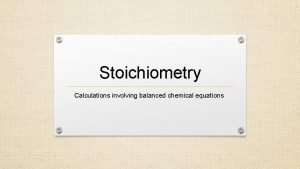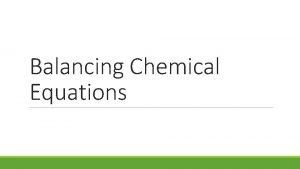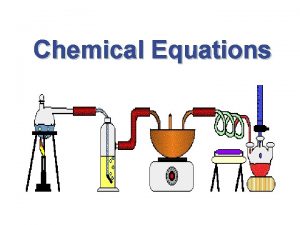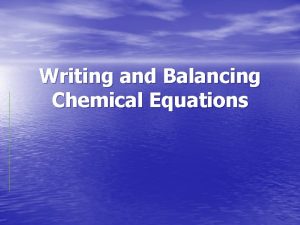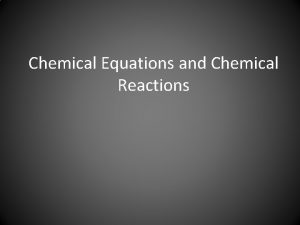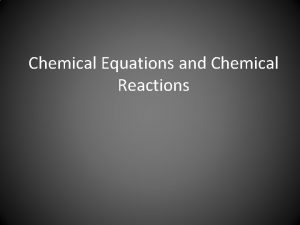Chapter 3 Calculations involving Chemical Formulae and Equations













- Slides: 13

Chapter 3 Calculations involving Chemical Formulae and Equations John A. Schreifels Chem 211 1

Contents • Mass and Moles of a Substance – Molecular weight – Moles • Determining Chemical Formulae – Mass % from formula – Elemental Analysis: gives % C, H, O – Determining formula from elemental analysis • Stoichiometry – Amounts of substances in a reaction – Limiting reagents John A. Schreifels Chem 211 2

Atomic and Molecular Weights • Molecular Weight (Formula weight): Summed masses of all atoms in the formula unit of the compound. • How? • For the general formula Aa. Bb. Cc. Dd. . . fm = formula mass = a MA + b MB + c MC + d MD +. . . • E. g. determine the formula mass (formula weight) of the following: • Na. OH, H 2 O, Ca. CO 3, C 2 H 6 O • Percentage composition from formula (mass % contribution of each element to the total mass of the compound). For Aa. Bb. Cc • E. g. determine the mass % composition of each element in: Na. OH, H 2 O, Ca. CO 3, C 2 H 6 O John A. Schreifels Chem 211 3

The Mole • Since individual atoms are very small, they weigh very little. It is not convenient deal with masses that small, since we can typically measure gram amounts in the lab. • Mole: Number of atoms (or molecules) as there are in 12. 00 g Carbon-12; 1 mol = 6. 02 x 1023 and is called Avogadro's number. • Mole is used to indicate a certain number of particles (like a dozen or bushel might be used). 1 mol of • water occupies approximately 18 m. L and has 6. 02 x 1023 molecules. • gold occupies approximately 10 m. L and has 6. 02 x 1023 atoms. John A. Schreifels Chem 211 4

Molar mass • 1 mol = FM = 6. 02 x 1023 particles • The definition of a mol allows us to perform a variety of conversions. • Let n = # mol, n’ = # atoms (molecules), m = mass and FM = formula mass then we can convert to: • m from n, FM E. g. Determine the mass of Na. Cl needed to have 5. 0 mol of it. • n from m, FM E. g. Determine the number of mol of Na. Cl in 15. 00 g of it. • n’ from n E. g. Determine the number of molecules in 3. 222 mol of Na. Cl • n’ from m, FM E. g. Determine the number of atoms in 4. 32 g of Na. Cl • m from n’, FM E. g. Determine the mass of one formula unit of Na. Cl. John A. Schreifels Chem 211 5

EMPIRICAL FORMULA Empirical Formula: Simplest formula where all coefficients are integers. • In earlier example Fe 2 O 3, Fe 4 O 6 Fe 6 O 9 Fe 8 O 12 possible formulas for iron oxide. Its empirical formula Fe 2 O 3. • Often obtained from % composition data. – – Assume 100 g of compound. Determine mol of each element. Divide by smallest # of moles. Multiply by smallest whole number to make all coefficients whole numbers. • E. g. Determine the empirical formula of a compound with the following % compositions: Mass%O = 34. 7% Mass%C = 52. 1% Mass%H = 13. 1% John A. Schreifels Chem 211 6

COMBUSTION ANALYSIS • Experimental mass % also determined. For organic compounds the sample is combusted. Analyzes the amount of C, H, and O in compounds. – C converted to CO 2 and mass measured. – H converted to H 2 O and mass measured • E. g. : Combustion analysis of a 1. 621 g sample of ethanol, which contains only C, H, O, was performed. Calculate the mass % composition of each element in ethanol. • Results: Mass CO 2 = 3. 095 g Mass of H 2 O = 1. 902 g. John A. Schreifels Chem 211 7

MOLECULAR FORMULA • Measure molecular mass • Multiply empirical mass by integer to obtain molecular mass. • Multiply all the co-efficients by this integer. • E. g. Determine the molecular mass of a compound with the empirical formula NO 2 and a molecular mass of 92. 00 g/mol. John A. Schreifels Chem 211 8

STOICHIOMETRY The relative amounts of reactants and products in a reaction are given by the ratio of stoichiometric coefficients. (Conservation of mass). • E. g. For the reaction : • 2 Na(s) + Cl 2(g) 2 Na. Cl(s) • 2 mol Na = 1 mol of Cl 2 = 2 mol of Na. Cl. • E. g. 2 Determine # mol of Cl 2 needed to react with 4. 2 mol of Na. How many mol of Na. Cl will form? • Mol of Cl 2 • Mol Na. Cl: • Summary: For a. A + b. B c. C John A. Schreifels Chem 211 9

STOICHIOMETRY 2 • Mass of one reactant can be related to the mass of another reactant or product. (Law of definite proportions). E. g. Determine the mass of Na needed to react with 34. 45 g of Cl 2 and the maximum mass of Na. Cl that could be produced. – Write reaction and express the moles of one compared to the moles of the other. – Substitute for mol in terms of mass and formula mass in each part. Let n = mol; FM = formula mass then E. g. 1: Determine the mass of oxygen consumed when it reacts with 10 g CH 3 CHO. E. g. 2. Calculate the mass of oxygen needed to react with 100 g Al to for Al 2 O 3. John A. Schreifels Chem 211 10

LIMITING REAGENTS • Limiting reagent: the reactant which limits the maximum amount of product that can be produced. It will be completely consumed in the reaction before any other reactants. • Limiting reagent must be known before theoretical yield can be determined. E. g. 1 Determine limiting reagent if 3. 00 moles of Al react with 2. 15 moles of O 2 to form Al 2 O 3. Strategy: – – – Determine mol of Al 2 O 3 that could be produced from Al Determine mol of Al 2 O 3 that could be produced from O 2 Reactant producing smallest amount of Al 2 O 3 is limiting reagent. E. g. 2 Calculate theoretical yield when 20 g Al react with 25 g O 2. Strategy: – – Determine expected yield from each reactant. Compare. If mass of Al 2 O 3 from produced from Al is less than from O 2, then Al is limiting. Otherwise O 2 is limiting. John A. Schreifels Chem 211 11

YIELDS IN CHEMICAL REACTIONS • Theoretical yield: the maximum amount of product that can be obtained from given amounts of reactants. • Actual Yield : the actual amount of product obtained from a reaction. • Theoretical yield calculated from amount of reactants and stoichiometry • Actual yield is the amount of product actually obtained. • % yield is the yield as a percent of theoretical yield: • E. g. The reaction for the synthesis of acetic acid from methanol is shown below. What is the % yield if 15. 0 g of methanol were combined with a stoichiometric amount of carbon monoxide to form 19. 1 g of product? CH 3 OH(l) + CO(g) HC 2 H 3 O 2(l) John A. Schreifels Chem 211 12

Summary • Moles are used to describe measurable quantities of a substance (1 mol = 6. 02 x 1023 particles). • Reactions occur in well defined proportions and are represented by balanced chemical equations. • The ratio of stoichiometric coefficients tells how much of one compound will react if we know the amount of the other: a. A + b. B c. C • Limiting reagent is one that limits the amount of product. Use it to determine the “theoretical yield”. • Empirical formula: simplest formula; all integers. • Molecular formula: actual formula of a compound. John A. Schreifels Chem 211 13
 Amount of substance
Amount of substance Are kc and kp equal
Are kc and kp equal Calculations involving colligative properties
Calculations involving colligative properties Structural steel connection calculations calculations
Structural steel connection calculations calculations Translating chemical equations
Translating chemical equations Series formula
Series formula Simultaneous equations involving logarithms
Simultaneous equations involving logarithms 2-5 solving equations involving absolute value answer key
2-5 solving equations involving absolute value answer key 2-5 solving equations involving absolute value
2-5 solving equations involving absolute value Linear equations involving fractions
Linear equations involving fractions Empirical formula pogil
Empirical formula pogil Chemical formulas and chemical compounds chapter 7
Chemical formulas and chemical compounds chapter 7 Chapter 8 review chemical equations and reactions section 2
Chapter 8 review chemical equations and reactions section 2 Chapter 8 section 1 chemical equations and reactions
Chapter 8 section 1 chemical equations and reactions
